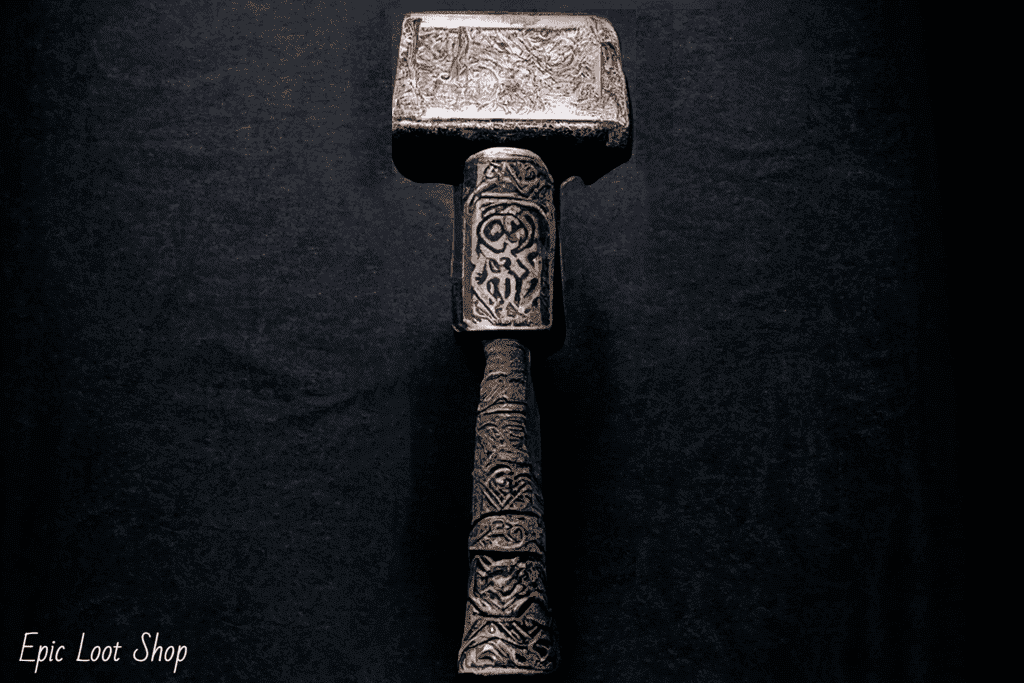Mjölnir - A Short Story
The hammer Mjölnir is one of the most powerful weapons in Norse mythology, able to level mountains and make you incredibly strong. Today we're going to be looking at the history of Mjölnir and how Thor's hammer came into existence.
Mjölnir was the most treasured weapon of Thor, the Norse god of thunder. This magnificent hammer Mjölnir was said to be indestructible. In order for his enemies to kill him, they had to get close to him and attack from behind by surprise. Mjölnir also gave power, might, and protection as well as divine authority to whoever wielded it in battle.
The sound of a thick branch breaking echoed off the forested hillsides around him as Thor, who was much more muscular than you'd expect for a Viking, struggled to control his momentum. If a treetrunk hadn't been there to absorb the shock, he probably would have snapped the branch in two and killed himself by slamming headfirst into the ground.
The Story Behind Thor's Hammer
A hammer is a hammer, right? Not necessarily. In the case of Mjolnir, it's so much more. Thor's Hammer isn't just any hammer—it has the power to summon lightning and allows its wielder to fly. It's also one of the most powerful weapons in the Marvel universe. And I mean, come on: how cool is that?
There are some theories as to how Mjolnir came into being. Most people believe it was forged by an alien race called the Dwarves, who reside in Nidavellir, which is located in Asgard (the realm where Thor lives). They used a mix of metal and mystical elements to create it, and they may have even helped construct Asgard itself.
Have you ever wondered how Mjolnir, Thor's legendary hammer, got its name? The answer dates back to when the pagan gods were still worshiped in Scandinavia. There are a few theories about how it got its original name, but the most popular one is that it was named after the sound of thunder. The Vikings were obsessed with thunder and lightning, and they often made offerings to the sky-god Thor to protect them from storms and keep them safe while they were at sea. Based on this theory, one of the first names for Mjolnir might have been "thunder" or "storm".
A few centuries later, Vikings began converting to Christianity. They believed that the old pagan gods were evil and deserved no further honor. But even though they tried as much as possible to suppress their ancient beliefs, some traditions became too deeply rooted in their culture or too useful to ignore. So instead of worshiping Thor directly, they started to symbolize him as an object: his hammer. They would carry small replicas of Mjolnir with them (known as "Thor's Hammers") into battle as a sign of their belief in his protection against evil spirits.
In a friendly tone: It's a classic scene from the Marvel comics, and it's now a classic question in many homes: "Where did you put the hammer?"The hammer in question isn't made of wood, metal, or any other material found in nature. The hammer is Mjolnir, Thor's legendary weapon which was forged with Asgardian magic and possesses several impressive abilities, including the power to summon the lightning Thor himself. A simple picture of the hammer can pop up anywhere around your house: on a photograph, a painting, or even an embroidery or doodle on someone's shirt or jacket. Some people have tattoos that feature it.
Thor has had several hammers throughout his long career as a superhero, but Mjolnir was his favorite by far. He carried it with him everywhere he went, and he used its powers so often that it became one of the most defining characteristics of his character.
It's not just a symbol of strength; it's the weapon that helped secure his place in Norse mythology.
What do the Vikings want Mjolnir to symbolize?
The Vikings created Mjolnir as a symbol of power, which is described in the Prose Edda. The story goes on to say that Odin gave his son Thor a powerful hammer that would have many positive effects on the world and its inhabitants.
The Norse god Thor carries a hammer named Mjolnir. In Norse mythology, the word Mjolnir was used to symbolize the power and strength of Thor. Mjolnir is also an icon of power, protection, and well-being according to Norse mythology.
You may know that Mjolnir, Thor's Hammer, is a powerful object. But what exactly does it symbolize? Many interpret this Norse relic as a symbol of Thor's power and nobility. But looking at the actual story of how Mjolnir was found and what it represents, these interpretations don't seem to make sense. The hammer represents something else entirely: Thor's humility. In the story of its creation and in the story of how it was lost and then found again, Loki plays a role in making sure that Thor fails at his mission—even though he has all the power in the world. It's only when Loki tricks him into giving up the power that Thor succeeds at his mission—he realizes he doesn't need to rely on his own strength to succeed and he can succeed through cooperation with others, even if they are his enemies.
Mjolnir, Thor's hammer, is a powerful and widely recognizable symbol of Norse mythology. It is said to be the weapon of choice for Thor, the god of thunder, lightning, and storms. The hammer is worn around Thor's belt, and can only be lifted by him. When he is in danger or in the need of assistance, he will lift his hammer to summon help from other gods and goddesses.
The name Mjolnir means "the crusher," but also "the grinder." The hammer was said to have been forged by the dwarves Brokkr and Sindri. The hilt was made of gold, with a leather band around it to hold it in place. The head was made of iron with a silver handle.
Here's How To Figure Out Who Can Lift Thor's Hammer
Anyone can lift Mjolnir, the hammer of Thor. And you don't need to be a Norse god to do it. The trick is in understanding the science behind its magic.
In the Marvel Comics universe, Mjolnir is depicted as a powerful weapon with a number of special qualities. It can change shape and size depending on the user, allowing them to throw it like a baseball or wield it as a hammer. It's also indestructible by conventional means; bullets bounce off it and hammers break against it. More importantly for our purposes here: Mjolnir only allows those worthy enough to lift it.
In order to lift Mjolnir, according to Marvel's comic book canon, you must be deemed "worthy" by Odin—the king of Asgard. You must have proven yourself to be selfless and strong of character, and you must prove your worth by demonstrating physical strength. Worthy characters have proven their worth in numerous ways—by volunteering for military service during wartime, by remaining noble in the face of temptation and adversity, or simply by having an excellent work ethic (okay yes this one is kind of boring).
When Thor's hammer (known as Mjolnir) was first introduced in the Marvel comics, it was said to have the power to only be lifted by those who were worthy. If a person tried to lift the hammer and failed, they would die. If someone else tried and failed, they would also die. In later comics, Thor clarified that the true test of worthiness was actually being able to lift his hammer without being deemed worthy—the hammer itself "judged" each person based on their heart and not just their physical strength.
In the world of physics, there's a similar test that can be used to determine if an object is really too heavy for you. The trick is to set up a scale with a scale pan on it that has an "unknown mass" or weight on one side and a known mass on the other side. Because both masses are known, you can use their relative weight to calculate how much your unknown mass weighs. This principle can be applied to lifting Thor's hammer: instead of just trying to lift it and dying like in the comic books, you're calculating its mass based on how high you have to lift it for it to balance out against your own body weight.
If you're a fan of Marvel, you've probably heard of the comic book character Thor. He's one of the most powerful superheroes in the universe, and his weapon is Mjolnir or the "Hammer of Thor." The hammer is so heavy that no one but Thor can lift it. But what if there were two Thors? Could both lift the hammer at once? How about three Thors? Or four? With a group of people all lifting together, could they lift it?
Some say Thor was born of rock and raised by giants, but I had other plans all along. I knew that this towering fool would never be able to walk amongst men. Our meeting happened all at once without any real communication. I can still recall the moment clearly when I lifted this heavy slab of granite over my head and twisted it into shape with my bare hands - the shape of Thor's mighty hammer, Mjölnir.
I hope you enjoyed this brief and amusing read. To be honest, I'm not entirely sure where it came from, but it's fun, albeit a bit silly. Please, let me know what you think in the comments below, or if there are any questions about my creative writing process or anything else, as I love to chat with you!




Laissez un commentaire